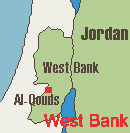


Excavations at ancient Jericho, identified as Tell al-Sultan, 10 km (6 mi)
north of the Dead Sea , have revealed remains of the oldest city yet
discovered by archaeologists. The earliest occupation of the site, dating
from the 10th millennium BC, consists of remains of the NATUFIAN culture
and includes what may have been a shrine. During the 8th millennium BC the
site was greatly expanded under a culture known as the Aceramic, or
Prepottery Neolithic , and a wall standing 5.2 m (17 ft) high was erected
around the settlement . On the west side were found remains of a round
tower that stood 7 m (23 ft) high and included an internal flight of steps.
Following a break the next city was populated by a culture known as the
Prepottery Neolithic (7th - 6th millennium BC). Houses of this phase were
rectangular and had beaten earth floors . That the two cultures represent
different groups is shown by significant changes in both the architectural
tradition and in the flint tools. Extraordinary finds of this period
included plastered skulls with shells replacing the eyes. These skulls,
found beneath the floors of houses .
In the ceramic stage of the Neolithic (6th-4th millennium BC) the dwellers
lived in pits and produced a characteristic painted pottery .
Early Bronze Age occupation (3100-2100 BC) was extensive and consisted of
large , well-built homes. Tombs were constructed for mass burials, and in
one such grave about 100 skulls were counted. Following the destruction of
the Early Bronze Age settlement, occupation was resumed by people who have
been identified with the AMORITES. They did not build a permanent
settlement and buried their dead in shaft tombs, the variety of whose grave
deposits may indicate tribal differences.
During the Middle Bronze Age (c.1900-1550 BC) houses consisting of small
irregularly shaped rooms were built. Mass burials were excavated in a
cemetery off the mound in shaft graves . The remains of wooden beds on
which the deceased lay as well as pottery vessels containing food and drink
have been found next to several of the bodies. The city was destroyed,
probably about the end of the Middle Bronze Age (1550BC).
